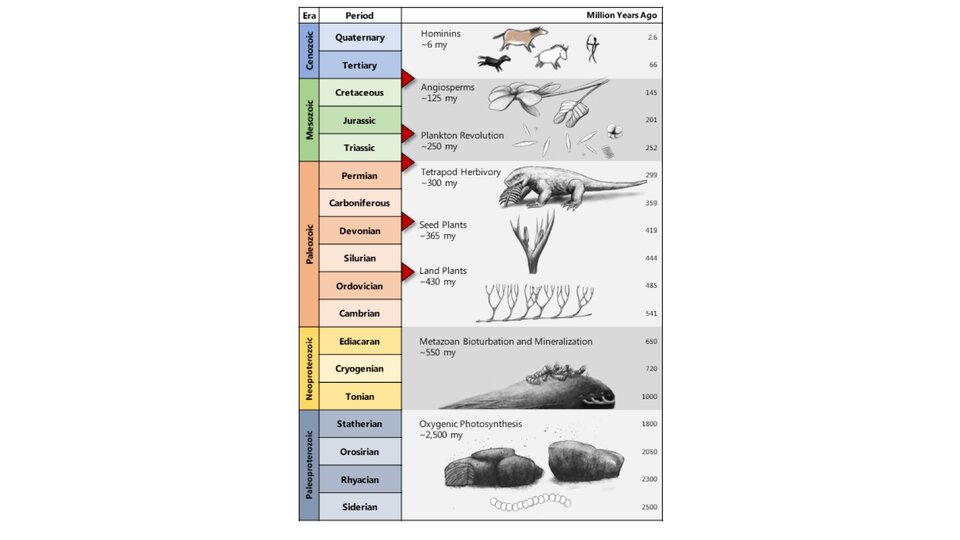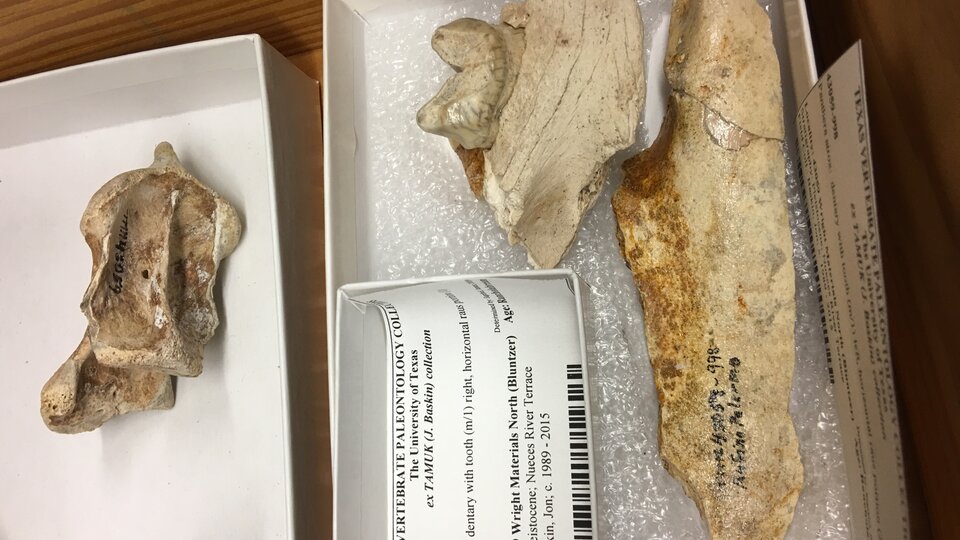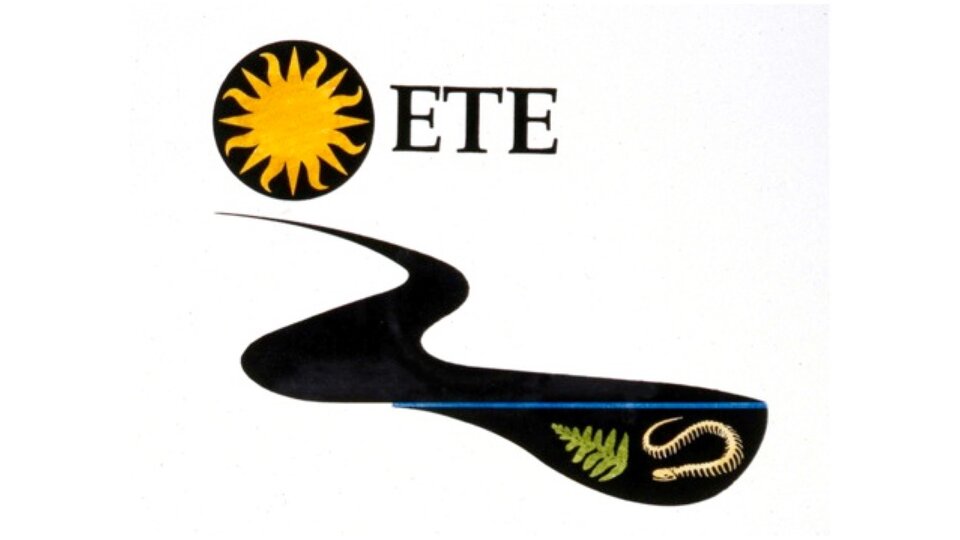Ecosystem Engineering over time
Major environmental changes can elevate extinction rates both by altering physical environments and from subsequent cascading trophic effects. However, the mechanisms for these environmental changes need not be abiotic. ‘Ecosystem engineers’, i.e., organisms that create and fundamentally modify habits in a manner that significantly affects resource availability for other life forms, have been a powerful geobiological force over the last 3.5 billion years of Earth history. Humans are the latest major ecosystem engineers. We are causing the extinction of species at rates that rival the largest biodiversity crises of the Phanerozoic. The fossil record records biotic responses to the evolution of ecosystem engineers and major environmental upheavals, which leads to the question: how do the effects of human ecosystem engineering compare to those of past ecosystem engineers and mass extinctions? To address this, I lead the “Ecological and Evolutionary Effects of Extinction and Ecosystem Engineers (E6)” Research Coordination Network with Simon Darroch of Senckenberg Institute and Museum of Natural History, Cindy Looy of the University of California Berkeley and Peter Wagner of the University of Nebraska Lincoln. The central question of the E6RCN is: what happens to ecosystem function and evolutionary dynamics after novel ecosystem engineers evolve, or across critical intervals that encompass major environmental change.
The macroecological and macroevolutionary consequences of mass extinctions are well‑studied as are the myriad proposed drivers of those extinctions. Although ecosystem engineering has been implicated as a driver of past evolutionary radiations and mass extinctions, work on ecosystem engineers has mainly been focused on ecological and microevolutionary effects. Although many effects of human ecosystem engineering have analogs with abiotic drivers of mass extinctions, studying the evolutionary history of past ecosystem engineering offers valuable data for predicting the long-term ecological effects of the Anthropocene. This project focuses on five major changes in the biosphere involving ecosystem engineers: the evolution of early metazoans during the Ediacaran-Cambrian transition, the rise of seed plants in the late Paleozoic, the rise of angiosperms, the evolution of hominins in the Pleistocene, and the Anthropocene. We will contrast these periods of ecosystem engineering with the effects of four of the five past mass extinctions in both the marine and terrestrial realms. The research generated by our RCN will shed new light on not only on macroevolutionary and macroecological dynamics, but also on how we expect the modern biosphere to respond to global anthropogenic change as well as the biological and ecological processes that help shape a habitable planet.

Biodiversity Loss
This project concerns one of humanity’s greatest challenges – how to slow down, halt, or mitigate the continued loss of biodiversity on Earth. With the exception of a few regions, such as African savannah ecosystems, the world has continued to lose much of its large animal biodiversity over the Holocene. Not surprisingly, a major focus of conservation biology is geared towards developing an synoptic understanding of how their loss may impact contemporary ecosystems. Employing a deeper time perspective can help provide insights into the crucial role megafauna play in ecosystem function, and the erosion that occurs with their loss.
Populations of large-bodied mammals are declining at an alarming rate. Their decline has serious ecosystem consequences because they have important functional roles, which are not replicated by smaller-bodied animals. Understanding how their decline or potential extinction will influence ecosystem processes is critically important and time sensitive, yet difficult to study in the modern. In collaboration with Felisa Smith at the University of New Mexico, I use the terminal Pleistocene megafauna extinction as an analogy for understanding ongoing and future biodiversity loss. Over the past 6 years, we have built an unparalleled late Quaternary fossil record for the mammal community of the Edwards Plateau, Texas. We employ modeling approaches, empirical characterizations of diet through stable isotopes, and 2D/3D imaging to quantify the ecological legacy of the terminal Pleistocene megafauna extinction in the Americas. Our current research aims to characterize the consequences of the extinction on communities, on earth systems, and on surviving animals, quantify if and how communities recovered, and investigate whether these patterns are influenced by the acceleration and expansion of human impacts over the late Holocene.
Community Assembly
The overall topic of community assembly and disassembly is of critical interest to both paleobiologists and ecologists but significant progress to integrate the data and theory of these two disciplines requires enhanced communication combined with tight focus on a specific problem. In collaboration with Kay Behrensmeyer at the National Museum of Natural History and Nick Gotelli at the University of Vermont, I led a multi-year Research Coordination Network applying current ecological theory and modeling to specific case studies grounded in field and collections-based research, focused on developing a new model for community assembly/disassembly in land ecosystems. Our network integrated information from the fields of paleobiology, geology, ecology, and anthropology and used this to address questions regarding community-level patterns and processes through the Phanerozoic record. We provided new perspectives on community change in the planet's ecosystems before human impacts and allowing us to compare what is happening now and predict what may happen in the future. Key findings from this group include showing that patterns of species co-occurrence were fundamentally altered by human impacts in the mid-Holocene (Lyons et al. 2016 Nature), that the changes in mammalican co-occurrence patterns after the megafaunal extinction were due to a loss of biotic interactions (Tóth et al. 2019 Science), and that mammal communities have been homogenizing since the beginning of the Holocene (Fraser et al. 2022 Nature Communications). In addition, this group developed new methods for evaluating the effects of the environment or dispersal limitation on species co-occurrence (Blois et al. 2014 Ecography) and the effects of species traits likes body size on species co-occurrence (Pineda-Munoz et al. 2021 Ecography).



